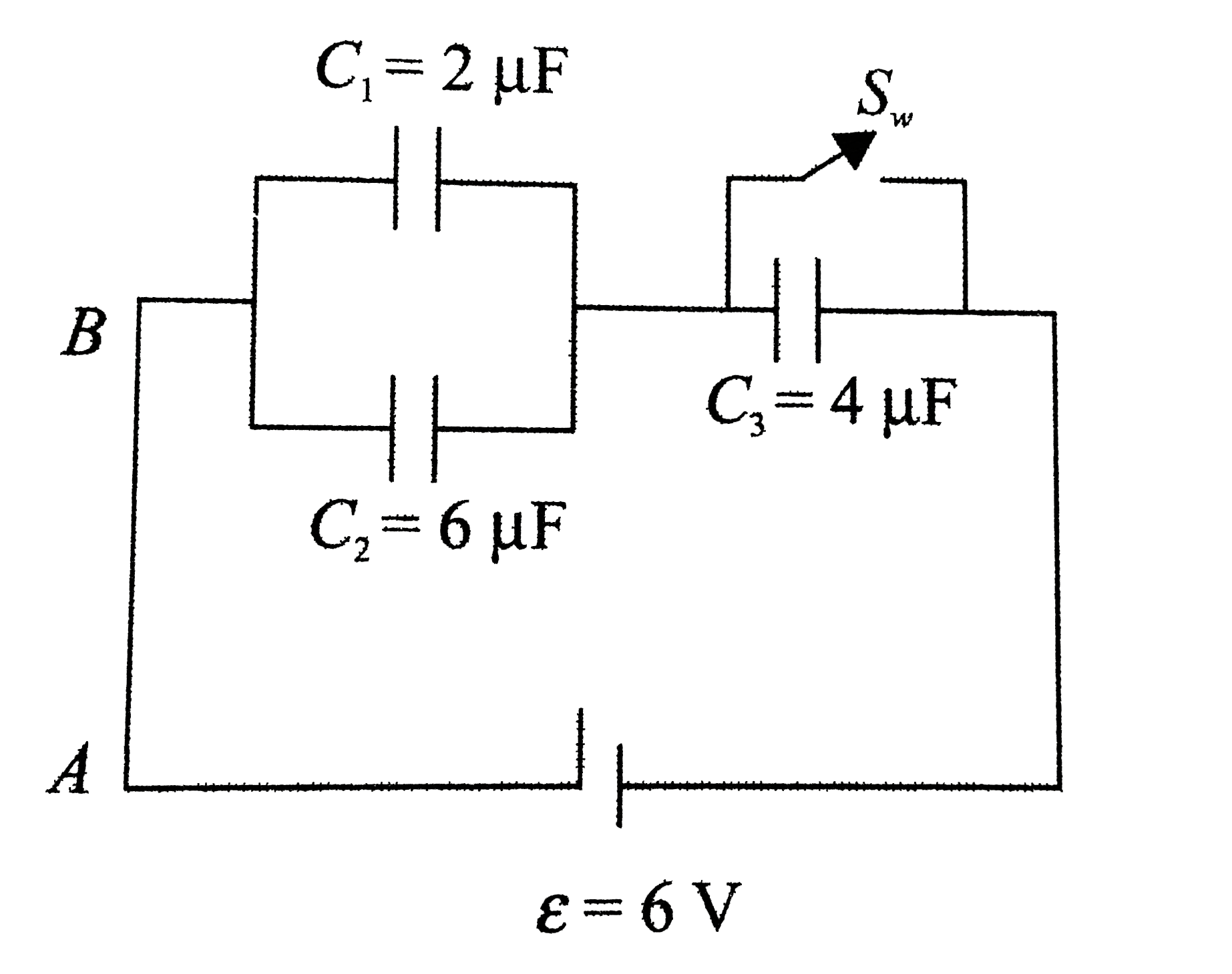The char5acteristic(s) common to urea, uric acidn and ammonia is/are
(i). Theya re nitrogenous wastes.
(ii). They all need very largwe amount of water for excretion.
(iii). They are all equally toxic.
(iv). They are produced in the kidneys
(i),(iii) and (iv)
(i) only
(i) and (iii)
(i) and (iv)
The correct Answer is:B
Urea, uric acid and ammonia are known as nitrogenous wastes as they are produced during protein metabolism. Ammonia needs very large amount of water for exretion, second in order comes urea and then uric acid. Ammonia is highly toxic, then comes urea and then uric acid. Ammonia is highly toxic, then comes urea and then uric acid. Ammonia and urea are produced in the liver and uric acid is formed mostly in the liver and to some extent in kidneys.
Topper's Solved these Questions
Similar Questions
In, all the capacitors are in steady state initially.
i. What is the charge flowing through the switch when it is closed?
ii. What is the charge flowing section AB?
iii. What is the work done by the battery?
iv. What is the heat produced when (S) is closed?
 .View Solution
.View SolutionWhat happens when?
(i) Acetamide is heated with bromine and caustic potash.
(ii) Acetyl chloride reacts with water.
(iii) Acetyl chloride is distilled with sodium acetate.
(iv) Acetamide reacts with nitrous acid.
(v) Acetamide reacts with phosphorus pentoxide.
(vi) Oils and fats are heated with NaOH.
(vii) Acetyl chloride reacts with ethyl alcohol.
(viii) Acetic acid is treated with P2O5 .
(ix) Urea is heated.
(x) Conc. HNO3 is added to concentrated urea solution.
(xi) Urea is heated with nitrous acid.
(xii) Urea is heated with sodium hydroxide solution.
(xiii) Urea is heated with acetyl chloride.
(xiv) The solution containing potassium cyanate and ammonium sulphate is evaporated to dryness.
(xv) Ammonia and carbon dioxide mixture is heated under pressureView Solution
Knowledge Check
- Question 1 - Select One
The characteristic that is shared by urea. Uric acid and ammonia is/are
(A) They are nitrogenous wastes
(B) The all need very large amount of water for excretion
(C) They are all equally toxic
(D) They are produced in the kidneysAA, C and DBA and DCA, C and BDA only - Question 2 - Select One
Read the following statements and find out the incorrect statements.
(a) Kidney plays very significant role in the removal of NH3
(b) Terrestial adaptation necessitated the production of more toxic nitrogenous wastes like urea and uric acid for conservation of water .
(c) Some amount of urea may be retained in the kidney matrix of some of the ureotelic animals to maintain a desired osmolarity.
(d) Uricotelic animals excrete nitrogenous wastes as uric acid in the form of pellet or paste with a minimum loss of water .Aa and bBb and cCc and dDa and d - Question 3 - Select One
Read the following statements.
(I) Ketonuria and glycosuria are characteristic symptoms of diabetes insipidus.
(II) Gynaecomastia is caused due to alteration in estrogen to androgen ratio.
(III) Except renin all other component of RAAS are produced by kidneys.
(IV) Generation of secondary messengers leads to the amplification of response generated for a hormone molecule.
Choose the option which includes correct statements only.AI & IIBII & IllCII onlyDII & IV
Which of the following statements are correct ?
(i)Arsenic and antimony are metalloids.
(ii) Phosphorus, arsenic and antimony are found
(iii) covalent radii increases equally from N to Bi.
(iv) Elements of group 15 have extra stability and higher ionisation energy due to exactly half filled ns2np3 electronic configuration.
(v) In group 15 elements only nitrogen is gas whereas all others are solids.View SolutionWhich of the following features (s) is/are common to both wind and water pollinated flowers?
I. Pollen grains are long and ribbon-like.
II. Stigma is large and feathery.
III. The flowers are not colourful.
IV. The flowers do not produce nectar.View SolutionCase 2 : the biological process involved in the removal of harmful metabolic wastes from the bosy is called excertion .Different organisms use varied strategies to do this Many unicellular organisms remove these wastes by simple diffusion from the body surface into the surrounding water while complex multicellular organisms use specialised organs to perform the same function .
Which of the following statements (s) is (are) true about excretion in human beings ?
(I) Urine is stored in the urethra until the urge of passing it out .
(II) Kidneys are the primary excretory organs .
(III) The bladder is muscular so it under nervous control .
(IV) Each kidney has large numbers of filtration units called nephrons .View SolutionWhich of the following statements is/are incorrect regarding the collecting duct?
(i). It extends from the cortex to medulla.
(ii). Large amount of water could be reabsorbed by it to produce concentrated urine.
(iii). Small amount of urea diffuses into it from the medulla to keep up the osmolarity.
(iv). it plays a role in maintaining pH and ionic balance of blood by the selective secretion of H+ and K+ ions.View SolutionWhich of the following statements are correct?
(i) Water logging increases the amount of salt in the soil that reduces soil fertility. (ii) 2, 4-D, MCPA and butachlor are common weedicides. (iii) Leguminous crops (like pea and beans) cannot be grouped in combination with cereals (like wheat and rice) under mixed cropping as both use large amount of nitrogen from the soil. (iv) Manures provide specific nutrients to the soil. (v) Paddy, maize, cotton and groundnut are examples of kharif crops while wheat, gram, pea and mustard are examples of rabi crops.View Solution

